AI Language Models Are Shaping Human Speech and Writing

Key Points
- LLMs like ChatGPT are trained on human text to sound like us.
- Researchers have observed a rise in AI‑favored words such as “realm” and “pivotal.”
- The phenomenon is called a “closed cultural feedback loop” or “echo effect.”
- AI‑styled language risks narrowing linguistic diversity by smoothing out regional quirks.
- Experts recommend drafting in one’s own voice before using AI for editing.
- Consciously varying language helps preserve individual expression.
- Reading human‑written content can counterbalance AI influence.
Large language models such as ChatGPT are designed to mimic human writing, but their widespread use is beginning to influence how people speak and write. Researchers have observed a measurable rise in AI‑favored words and phrases, describing a “closed cultural feedback loop” in which machine‑generated language echoes back into human communication. This “echo effect” risks narrowing linguistic diversity as AI‑styled phrasing becomes the norm. Experts recommend preserving a personal voice by drafting in one's own style before using AI tools and consciously varying language to maintain variety.
The Rise of an AI Echo Effect
ChatGPT and other large language models are built to sound like humans, having been trained on vast amounts of human‑written text. As these tools proliferate, researchers have documented a noticeable increase in the use of words and expressions that are favored by AI, such as “realm,” “pivotal,” and “meticulous.” The phenomenon has been labeled a “closed cultural feedback loop,” where the language generated by machines feeds back into human communication, reinforcing the same patterns.
Associate Professor Ritesh Chugh describes this as the “echo effect.” He notes that frequent exposure to AI‑generated content leads people to adopt its vocabulary and phrasing without deliberate copying. The effect extends beyond written text, influencing spoken language as well.
Potential Risks to Linguistic Diversity
The growing prevalence of AI‑styled language raises concerns about the erosion of linguistic and cultural diversity. Because AI models aim for smooth, neutral, and professional prose, they tend to smooth out regional quirks, idiomatic expressions, and individual stylistic flourishes. Over time, this could result in a more homogenized mode of communication, limiting the richness of human expression.
The research suggests that while the influence is measurable, it is not yet dominant. Nonetheless, the risk remains that continued exposure may narrow the range of words and phrases people consider natural, leading to a more uniform linguistic landscape.
Guidance for Preserving a Human Voice
Experts advise conscious strategies to maintain variety in communication. One recommendation is to write the initial draft in one's own voice before turning to AI tools for editing or polishing. By doing so, writers can retain their unique style and then selectively incorporate AI suggestions.
Another suggestion is to actively seek out and read human‑authored content, thereby reinforcing diverse linguistic patterns. When AI‑generated text is reviewed, readers should watch for overused phrases and replace them with simpler or more original alternatives. These practices help ensure that the human voice remains distinct and vibrant amid growing AI influence.